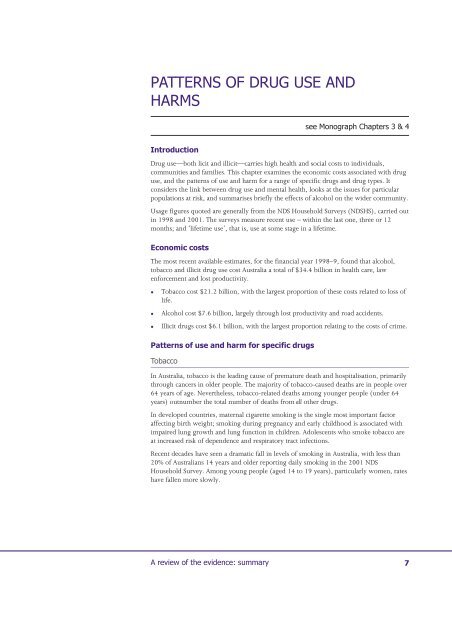Summary - Department of Health and Ageing
Summary - Department of Health and Ageing
Summary - Department of Health and Ageing
You also want an ePaper? Increase the reach of your titles
YUMPU automatically turns print PDFs into web optimized ePapers that Google loves.
Drug use—both licit <strong>and</strong> illicit—carries high health <strong>and</strong> social costs to individuals,<br />
communities <strong>and</strong> families. This chapter examines the economic costs associated with drug<br />
use, <strong>and</strong> the patterns <strong>of</strong> use <strong>and</strong> harm for a range <strong>of</strong> specific drugs <strong>and</strong> drug types. It<br />
considers the link between drug use <strong>and</strong> mental health, looks at the issues for particular<br />
populations at risk, <strong>and</strong> summarises briefly the effects <strong>of</strong> alcohol on the wider community.<br />
Usage figures quoted are generally from the NDS Household Surveys (NDSHS), carried out<br />
in 1998 <strong>and</strong> 2001. The surveys measure recent use – within the last one, three or 12<br />
months; <strong>and</strong> ‘lifetime use’, that is, use at some stage in a lifetime.<br />
<br />
The most recent available estimates, for the financial year 1998–9, found that alcohol,<br />
tobacco <strong>and</strong> illicit drug use cost Australia a total <strong>of</strong> $34.4 billion in health care, law<br />
enforcement <strong>and</strong> lost productivity.<br />
<br />
<br />
<br />
Tobacco cost $21.2 billion, with the largest proportion <strong>of</strong> these costs related to loss <strong>of</strong><br />
life.<br />
Alcohol cost $7.6 billion, largely through lost productivity <strong>and</strong> road accidents.<br />
Illicit drugs cost $6.1 billion, with the largest proportion relating to the costs <strong>of</strong> crime.<br />
<br />
<br />
In Australia, tobacco is the leading cause <strong>of</strong> premature death <strong>and</strong> hospitalisation, primarily<br />
through cancers in older people. The majority <strong>of</strong> tobacco-caused deaths are in people over<br />
64 years <strong>of</strong> age. Nevertheless, tobacco-related deaths among younger people (under 64<br />
years) outnumber the total number <strong>of</strong> deaths from all other drugs.<br />
In developed countries, maternal cigarette smoking is the single most important factor<br />
affecting birth weight; smoking during pregnancy <strong>and</strong> early childhood is associated with<br />
impaired lung growth <strong>and</strong> lung function in children. Adolescents who smoke tobacco are<br />
at increased risk <strong>of</strong> dependence <strong>and</strong> respiratory tract infections.<br />
Recent decades have seen a dramatic fall in levels <strong>of</strong> smoking in Australia, with less than<br />
20% <strong>of</strong> Australians 14 years <strong>and</strong> older reporting daily smoking in the 2001 NDS<br />
Household Survey. Among young people (aged 14 to 19 years), particularly women, rates<br />
have fallen more slowly.

















